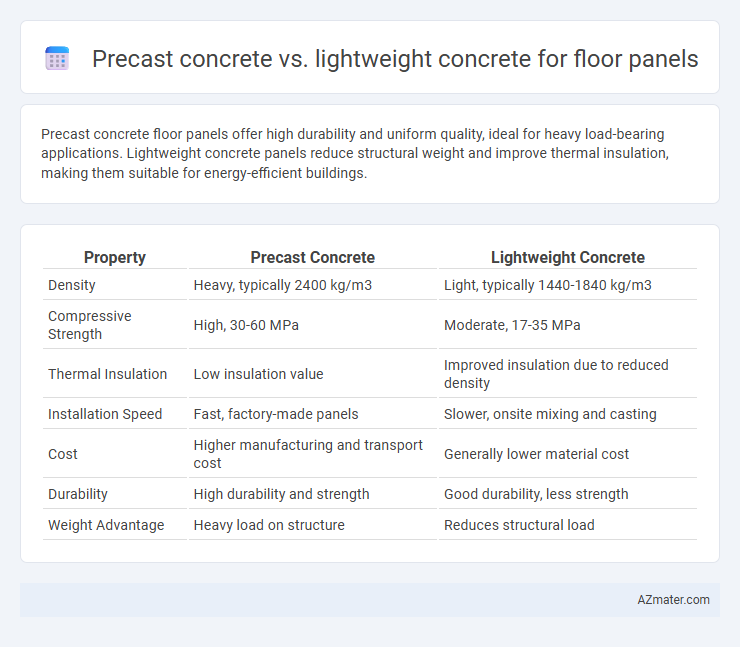Precast concrete floor panels offer high durability and uniform quality, ideal for heavy load-bearing applications. Lightweight concrete panels reduce structural weight and improve thermal insulation, making them suitable for energy-efficient buildings.
Table of Comparison
| Property | Precast Concrete | Lightweight Concrete |
|---|---|---|
| Density | Heavy, typically 2400 kg/m3 | Light, typically 1440-1840 kg/m3 |
| Compressive Strength | High, 30-60 MPa | Moderate, 17-35 MPa |
| Thermal Insulation | Low insulation value | Improved insulation due to reduced density |
| Installation Speed | Fast, factory-made panels | Slower, onsite mixing and casting |
| Cost | Higher manufacturing and transport cost | Generally lower material cost |
| Durability | High durability and strength | Good durability, less strength |
| Weight Advantage | Heavy load on structure | Reduces structural load |
Introduction to Floor Panel Solutions
Precast concrete floor panels offer high structural strength and durability, making them ideal for commercial and industrial buildings requiring rapid installation and load-bearing capacity. Lightweight concrete floor panels reduce overall building weight, improve thermal insulation, and provide ease of handling, making them suitable for residential and retrofit projects. Choosing between precast and lightweight concrete depends on project-specific requirements such as load, installation speed, and thermal performance.
Overview of Precast Concrete
Precast concrete floor panels are manufactured in controlled factory settings, offering high strength, durability, and precise dimensions tailored to construction requirements. These panels facilitate rapid installation, reduce on-site labor costs, and ensure consistent quality compared to cast-in-place methods. Their superior load-bearing capacity and resistance to fire and weather make precast concrete an optimal choice for structural floor systems.
Overview of Lightweight Concrete
Lightweight concrete for floor panels offers reduced density ranging from 800 to 1840 kg/m3, significantly lowering the dead load compared to traditional precast concrete, which typically weighs around 2400 kg/m3. This type of concrete incorporates lightweight aggregates such as expanded clay, shale, or pumice, enhancing thermal insulation and fire resistance while maintaining adequate compressive strength for structural applications. The use of lightweight concrete in floor panels promotes easier handling, faster installation, and improved energy efficiency in building designs.
Key Differences Between Precast and Lightweight Concrete
Precast concrete floor panels are manufactured in controlled factory environments ensuring high strength, durability, and precise dimensions, while lightweight concrete offers reduced density and improved thermal insulation suitable for energy-efficient designs. Precast concrete typically features higher compressive strength ranging from 30 to 50 MPa, compared to lightweight concrete's strength between 17 to 35 MPa, making precast ideal for heavy load-bearing floors. Lightweight concrete panels reduce structural dead loads by up to 20-30%, enhancing seismic performance and ease of installation, but precast panels provide superior uniformity and faster construction timelines due to factory production methods.
Strength and Load-Bearing Capacity Comparison
Precast concrete floor panels typically exhibit higher compressive strength, often ranging from 30 to 50 MPa, compared to lightweight concrete panels which usually fall between 17 to 30 MPa due to their lower density and inclusion of lightweight aggregates. The load-bearing capacity of precast concrete is superior, supporting heavier structural loads and making it suitable for high-rise buildings and industrial applications. Lightweight concrete panels prioritize thermal insulation and ease of handling but have a reduced capacity for heavy loads, making them ideal for residential and non-load critical structures.
Installation and Construction Efficiency
Precast concrete floor panels offer rapid installation due to factory-controlled quality and pre-fabrication, reducing on-site labor and construction time significantly. Lightweight concrete panels, while easier to handle and transport because of their reduced weight, may require longer curing times and specialized formwork that can slow down the construction process. Choosing precast concrete enhances overall efficiency by minimizing delays and ensuring consistent panel quality, whereas lightweight concrete improves maneuverability but may impact the speed of project completion.
Durability and Maintenance Factors
Precast concrete floor panels offer superior durability with high resistance to cracks, weathering, and heavy loads due to their controlled manufacturing environment and dense composition. Lightweight concrete panels, while easier to handle and install, generally exhibit lower compressive strength and higher porosity, which can lead to increased maintenance needs such as sealing and repair over time. Maintenance frequency for lightweight concrete panels tends to be higher to prevent moisture penetration and ensure long-term performance compared to the more robust and longer-lasting precast concrete alternative.
Cost Analysis: Precast vs Lightweight Concrete
Precast concrete floor panels generally offer lower labor and installation costs due to factory-controlled production and faster onsite assembly, which reduces construction time and associated expenses. Lightweight concrete panels, though providing benefits like reduced structural load and improved thermal insulation, often incur higher material costs and longer curing times that can increase overall project expenditure. Evaluating cost-effectiveness depends on project scale, labor availability, and performance requirements, with precast concrete favored for cost-sensitive, large-scale applications.
Environmental Impact and Sustainability
Precast concrete floor panels typically offer lower environmental impact due to factory-controlled production minimizing waste and ensuring consistent quality, which reduces the need for repairs and replacement. Lightweight concrete panels, made with less dense aggregates, improve energy efficiency in buildings by providing better thermal insulation and reducing cooling and heating demands. Choosing between the two involves balancing the lower embodied carbon and waste reduction of precast methods against the enhanced operational energy savings from lightweight concrete's insulating properties.
Choosing the Right Concrete for Floor Panels
Selecting the right concrete for floor panels requires evaluating strength, weight, and durability factors. Precast concrete offers superior compressive strength and consistent quality, making it ideal for heavy-load applications and repetitive manufacturing. Lightweight concrete, with reduced density and improved thermal insulation, benefits projects prioritizing ease of handling and energy efficiency without compromising structural performance.

Infographic: Precast concrete vs Lightweight concrete for Floor panel
 azmater.com
azmater.com